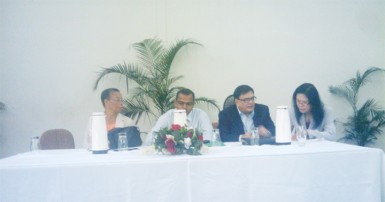The University of Guyana (UG) yesterday launched the long-delayed World Bank-funded US$10M Science and Technology Support Project (STSP).
During the launch, University Pro Chancellor Prem Misir stated that the project has the potential to make the institution a regional and international leader in environmental and biodiversity matters.
The STSP is an initiative birthed by the Government of Guyana (GOG) in support of the implementation of its Low Carbon Development Strategy (LCDS).

The project will finance three components: The Education Quality Improvement Programme will revitalise the university’s science curriculum and support more applied research towards meeting the critical needs for the LCDS, while the Infrastructure Rehabilitation aspect will include improving laboratory and building infrastructure at four faculties in a total of 14 buildings; providing these laboratories with scientific equipment to enable the delivery of practical science education and research as well as establishing a campus wide internet network.
The third component – Institutional Capacity Building – will support UG in managing, monitoring and evaluating the project as well as planning for future phases of its strategic plan.
The initial proposal for the project, which was made by the Office of the President (OP), came in the form of a US$10M Biodiversity Centre Building for the School of Earth and Environmental Sciences. This proposal was turned down by the World Bank who said that they could not facilitate funds for the building. With little time remaining before the last of low cost funds for education for highly indebted nations deadline expired, the government quickly reconfigured the proposal and included major infrastructural, academic, and development efforts
Marlene Cox, UG’s Director, Offices of Resource Mobilisation and Planning, explained that the new project document was presented to and accepted by the WB Directors on June 23rd 2011. This left an 18-month agreement deadline, after which the possibility of collecting on the loan would be terminated.
‘Challenges,
opportunities’
Noting that the initial discussions started only 18 months ago, Operations Officer and Team Leader of the STSP Hongyu Yang commended the government on having completed all of the prerequisites for the agreements in “record time.”
She warned, however, that the most delicate and important aspect of the project is still to commence. “Now is the time for implementation, a period that will pose great challenges as well as opportunities,” said Yang.
The Ministry of Education in collaboration with UG has been given the responsibility for the execution of the project, which will span a five-year period (2012-2017). It has been agreed that US$2M will be released by the Bank each year for five years.
The project’s objective essentially is to strengthen UG’s faculties of Agriculture and Forestry, Natural Sciences and Technology and the School of Earth and Environmental Science, through curriculum reviews and research to support more advanced infrastructure and capacity to facilitate effective implementation of the LCDS.
Cox emphasized, though, that it is the School of Earth and Environment that will remain pertinent to improving the university’s ability to build the capacity needed to successfully implement and maintain the LCDS. This will be done through the development of a tailored curriculum as well as the forging of the necessary skill sets.
Cox said that this loan and its ensuing components constitute the largest project for institutional development that the university has ever undertaken. She conceded, however, that the loan will not address all of the university’s needs, such as better lecture halls and other technical facilities.
‘Crisis’
Meanwhile, Misir said that these undertakings could not have come at a better time. He said that Guyana is experiencing a “biodiversity crisis,” which we cannot fully comprehend or evaluate because we have not developed a system to take such losses into account. The loss of our fresh soils, wetlands and forests translates into the loss of natural revenue, which we do not fully comprehend, he added. The loss of our natural resources, he further said, negatively impacts public health, food security as well as consumer choice.
However, he was confident that the project’s implementation should lead to decreased deforestation and forest degradation, increased mitigation and adaptation, and an all-round favourable atmosphere for the realisation of the LCDS. More importantly, Misir said that he hoped that advancement in this area will be able to make apparent the link which exists between environmental degradation and rural poverty.
Speaking in his capacity as acting Education Minister, Frank Anthony said that UG must align its programmes to help with the implementation of the LCDS, since it would help mitigate the effects of climate change. He also urged the institution to engage in more independent initiatives, such as partnerships with private entities, since it has a monumental role to play in the development of science and technology in Guyana. This, he added, will avail it the knowledge of what skill sets are in demand, enabling it to tailor its curricula to provide relevantly-skilled human resources.
Approximately 6,000 students and 300 staff are poised to directly benefit from this project, while private sector employees, local communities and international researchers engaged in rainforest conservation and biodiversity preservation are among the indirect beneficiaries. Success will be determined based on four indicators: new investments in buildings, equipment and ICT maintained in working order; whether studies produced by the project are incorporated into the UG Strategic Plan; and an increase in student, faculty and private sector satisfaction with the strength of the four science faculties at UG.









